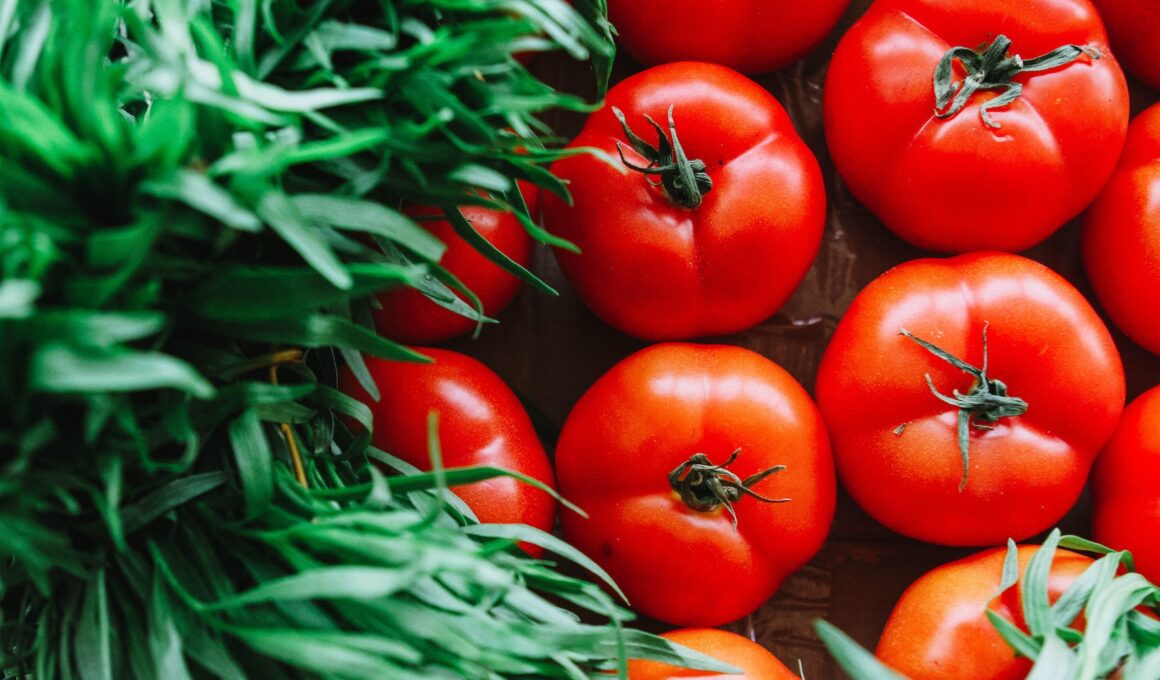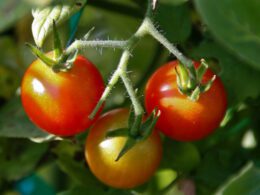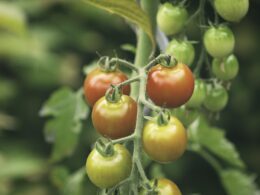You’ve planted your tomato seeds, watched them grow, and now you’re looking forward to a bountiful harvest. But wait! You’ve heard that pruning tomatoes can increase their chances of producing more fruit. Is it true? Or does pruning actually reduce yield?
In this article, we’ll explore the science behind pruning tomatoes and help you decide whether or not it’s worth taking up those shears. Don’t worry; we’re here to guide you through the process, step by step. We’ll break down the structure of a tomato plant, discuss different methods of pruning, and determine the optimal time to do so.
Together, we’ll weigh the pros and cons of pruning tomatoes to ensure your plants have the best chance at a successful harvest season while keeping them safe from diseases. So grab your gardening gloves and let’s get started on understanding how pruning affects tomato yields!
Understanding the Tomato Plant Structure
Let’s dive into the world of tomato plants and figure out their unique structure! Tomato plants have a main stem, which grows vertically, and along this stem, you’ll find branches with leaves and flowers.
These branches are called ‘suckers’ because they can grow out from the leaf axils (the point where the leaf connects to the stem) and develop into additional stems.
Now, why is it important to know about suckers? Well, these suckers can become quite crowded on your tomato plant if left unchecked. When there are too many suckers competing for nutrients and sunlight, it can lead to a weaker overall plant.
That’s where pruning comes in – by removing some of these unneeded growths, you’ll be helping your tomato plant focus its energy on growing bigger fruits.
So what does this mean for your tomato yield? Pruning helps redirect your plant’s energy toward producing better quality tomatoes instead of just more foliage. While it may seem counterintuitive at first, controlling the number of suckers on your plant will ultimately result in healthier fruit production.
So don’t worry too much about reducing yield when pruning; instead, think about how you’re giving your beloved tomato plants an opportunity to thrive!
The Science Behind Pruning Tomatoes
You might be wondering if cutting back your tomato plants could actually lead to fewer fruits, so here’s the scoop on the science behind it. Pruning tomatoes is all about managing the plant’s energy and growth. By removing some of the branches and leaves, you’re allowing the plant to focus its resources on producing larger, tastier fruits instead of spending energy on unnecessary foliage.
Pruning has several benefits. Firstly, it helps increase air circulation around the plant, reducing the risk of diseases like blight or fungal infections that can devastate your crop. Secondly, removing weaker branches allows for stronger stems to support larger fruit clusters without breaking or bending under their weight. Lastly, by thinning out excess foliage, more sunlight reaches your developing tomatoes, leading to faster ripening and better flavor.
So while it may seem counterintuitive at first glance, pruning your tomato plants can indeed result in a higher yield of quality tomatoes. The key is knowing which parts of the plant to trim away and when to do it during its growth cycle. With proper pruning techniques and care, you’ll have an abundant harvest of delicious homegrown tomatoes that you can enjoy with confidence in their safety from disease and damage.
Different Methods of Pruning Tomatoes
Now that you’re familiar with the benefits, it’s time to explore various methods for trimming those tomato plants to perfection.
The first method is called single-stem pruning, which involves removing all side shoots or suckers from the main stem of your tomato plant. To do this, pinch off the small growths between the main stem and leaf branches when they’re about 1-2 inches long. This will encourage a strong central stem and help prevent disease by promoting better airflow.
Another technique to consider is Missouri pruning, which allows some side shoots to grow but still helps maintain an orderly plant structure. With this method, instead of pinching off the entire sucker, simply remove its tip leaving about two leaves on it. This way, you’ll achieve better light penetration and air circulation while still allowing your tomato plants to produce more fruit than in single-stem pruning.
Lastly, there’s minimal pruning – perfect for those who want a low-maintenance approach without sacrificing too much yield. In this case, you only need to remove any dead or yellowing leaves as well as any suckers growing below the first flower cluster.
By doing this simple task regularly throughout the growing season, you can keep your tomatoes healthy and avoid overcrowding issues without investing too much time or effort into plant maintenance.
So go ahead and give these methods a try – your abundant harvest awaits!
Can Pruning Tomato Plants Actually Increase Fruit Production?
Can trimming tomato plants for increased fruit production actually work? Many gardeners believe so. By pruning back tomato plants, you can redirect the plant’s energy towards fruit production rather than excessive foliage growth. Trimming helps improve airflow and sunlight penetration, minimizing diseases and fostering better overall plant health. However, it’s crucial to follow proper pruning techniques and understand the specific needs of each tomato variety for optimal results.
The Optimal Time to Prune Tomato Plants
It’s essential to know the optimal time to prune your tomato plants for a bountiful harvest.
Start with early season pruning, follow up with mid-season maintenance, and finish strong with late-season clean-up.
By following this timeline, you’ll ensure healthy growth and maximize your tomato yield.
Early season pruning
In the early stages of growth, strategic trimming can actually enhance a plant’s productivity and overall health. By removing excess foliage and focusing on the main stem, you’re allowing your tomato plants to develop a strong support system against wind and pests.
Additionally, pruning at this stage helps to direct more energy towards fruit production rather than unnecessary leaf growth. When it comes to early season pruning, less is more.
Start by pinching off any suckers or side shoots that appear between the main stem and branches. This allows your plant to put its energy into producing larger, higher-quality tomatoes instead of wasting resources on smaller fruits.
Keep an eye out for any yellowing leaves or signs of disease as well—removing these promptly will help maintain a healthy environment for your plants, ensuring they grow strong and produce plenty of delicious tomatoes for you to enjoy!
Mid-season maintenance
Mid-season maintenance is crucial for a flourishing tomato garden, as it’ll ensure optimal growth and bountiful harvests. At this stage, you need to keep an eye on your plants’ health and support their growing needs. Here are some essential tasks you should perform during mid-season:
-
Pruning:
-
Remove any suckers or side shoots that steal nutrients from the main stem.
-
Eliminate yellowing or diseased leaves to prevent the spread of disease.
-
Maintain air circulation by trimming back dense foliage.
-
Staking and tying:
-
Secure your plants to stakes or cages for added support.
-
Gently tie stems with soft twine, leaving room for growth.
-
Adjust ties as needed throughout the season.
-
Watering and feeding:
-
Water deeply at least once a week, especially during dry spells.
-
Provide regular feedings with a balanced fertilizer to promote healthy growth.
-
Mulch around the base of your plants to retain moisture and control weeds.
By keeping up with these mid-season maintenance tasks, you can protect your tomatoes from pests and diseases while promoting better fruit production. And although pruning may seem counterintuitive when trying to maximize yield, it’s important to remember that strategic pruning will actually increase overall production by allowing more nutrients and energy to be directed towards fruit development. So go ahead – give those tomato plants some TLC during mid-season maintenance, ensuring a safe haven in which they can thrive!
Late-season clean-up
As the season winds down, it’s essential to give your tomato garden some final attention with late-season clean-up tasks. This helps protect your plants from disease and ensures a healthy start for next year’s crop.
Start by removing any remaining fruit, whether ripe or unripe, as well as dead leaves and branches. Dispose of this debris in the trash or compost away from your garden to prevent the spread of diseases.
Next, sanitize your gardening tools to avoid transferring any lingering pathogens to other plants or next year’s tomatoes. A simple solution of bleach and water should do the trick – just make sure you rinse them thoroughly afterward!
By keeping up with these late-season maintenance steps, you’ll be safeguarding both your current yield and future harvests while giving yourself peace of mind knowing that you’ve done everything possible to keep your garden safe and healthy.
Weighing the Pros and Cons of Pruning Tomatoes
You might be wondering if there are any drawbacks to trimming your tomato plants, and whether it could potentially impact the overall harvest. Well, pruning tomatoes can indeed have both pros and cons.
On one hand, it helps prevent diseases by improving airflow around the plant and reducing humidity. It also encourages the growth of stronger stems that can support heavier fruit loads. However, excessive pruning may lead to reduced yields because you’re removing foliage that’s responsible for photosynthesis – the process plants use to convert sunlight into energy.
When considering whether or not to prune your tomato plants, it’s essential to weigh these factors carefully. Too much pruning can cause your plant to produce fewer fruits since you’re taking away its ability to create energy efficiently. On the other hand, not pruning at all could result in weak stems that struggle under heavy loads of fruit or an increased risk of disease due to poor air circulation around damp leaves.
Ultimately, finding a balance is key when it comes to pruning tomatoes. Be mindful of how much foliage you remove so as not to hinder your plant’s energy production but still allow for sufficient airflow and stem strength. By being cautious with your pruning techniques and striking this delicate balance, you’ll be able to enjoy a healthy harvest while minimizing risks associated with overgrown or poorly maintained tomato plants.
Conclusion
So, does pruning tomatoes reduce yield? It depends on how you do it. Proper pruning can actually boost your tomato harvest while improving plant health.
Keep in mind the timing and methods we discussed above to find the best balance for your garden.
Happy growing!








